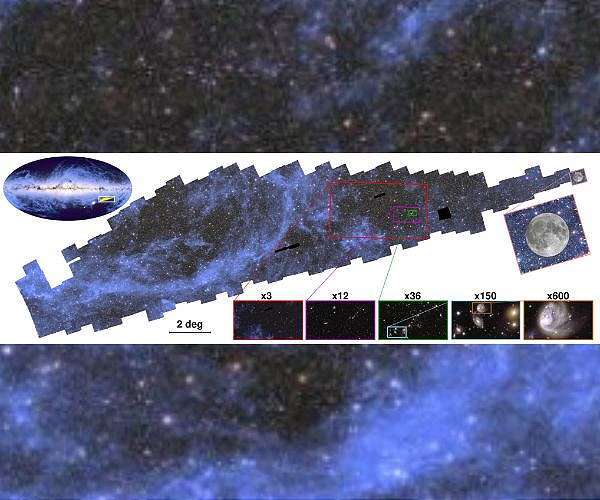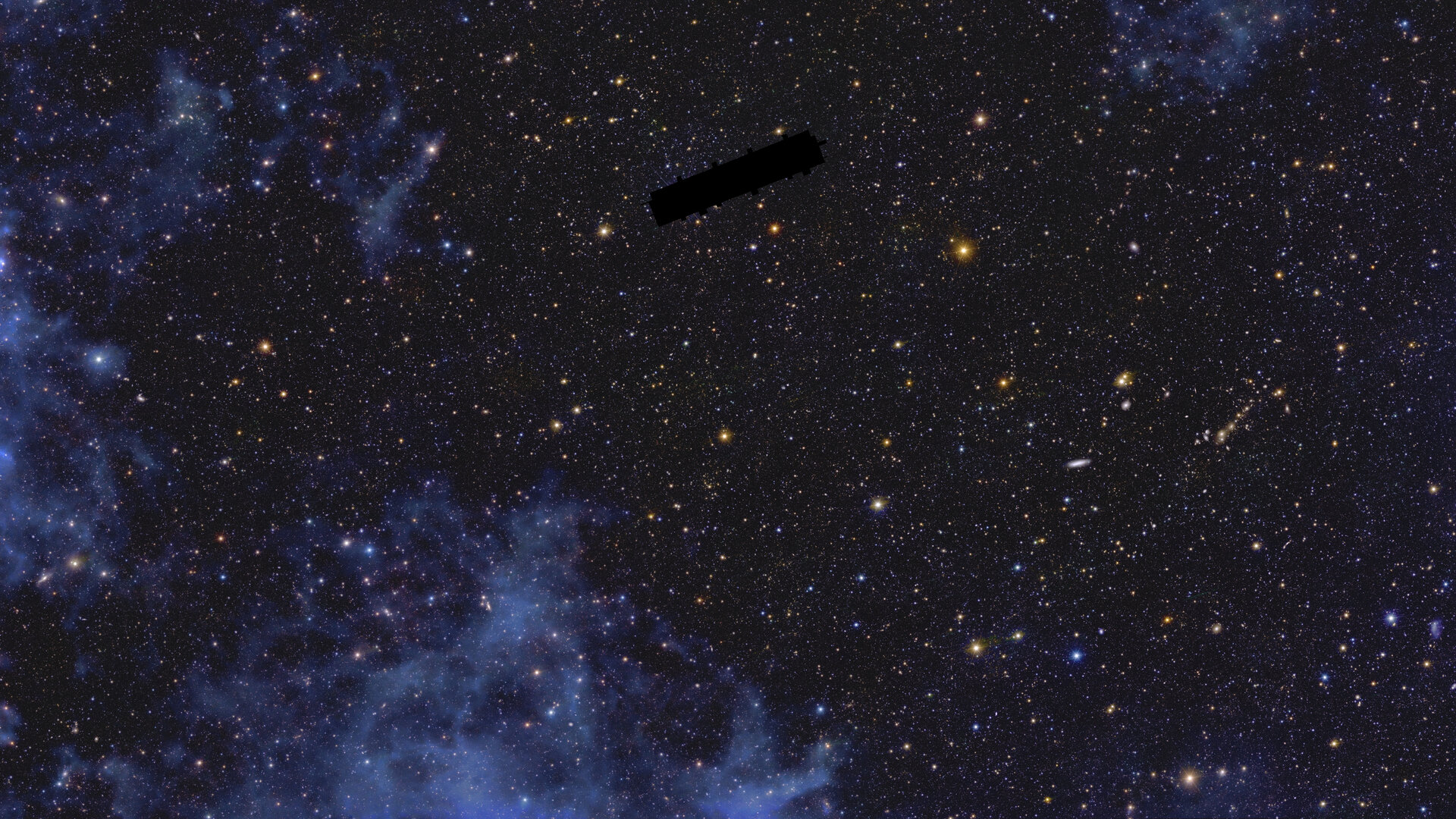17.10.2024

This graphic provides an overview of the mosaic and zoomed in images released by ESA's Euclid mission on 15 October 2024.
On 15 October 2024, ESA's Euclid space mission unveiled the first segment of its vast cosmic map, showcasing millions of stars and galaxies.
Presented at the International Astronautical Congress in Milan, Italy, by ESA's Director General Josef Aschbacher and Director of Science Carole Mundell, this initial section is an impressive 208-gigapixel mosaic. Compiled from 260 observations conducted between 25 March and 8 April 2024, the map spans 132 square degrees of the Southern Sky, covering an area more than 500 times larger than the full Moon.
This mosaic represents just 1% of the extensive survey Euclid will complete over the next six years, which aims to study the shapes, distances, and motions of billions of galaxies up to 10 billion light-years away. By the end of the mission, Euclid will have created the largest-ever 3D map of the cosmos.
Already, the first portion of the map captures about 100 million celestial sources, including stars from the Milky Way and distant galaxies. Among these, approximately 14 million galaxies can be used to explore the elusive effects of dark matter and dark energy in shaping the Universe.
"This stunning image is the first piece of a map that in six years will reveal more than one third of the sky. This is just 1% of the map, and yet it is full of a variety of sources that will help scientists discover new ways to describe the Universe," commented Valeria Pettorino, Euclid Project Scientist at ESA.
The space telescope's powerful cameras captured a remarkable number of objects in high detail. Even when zoomed in 600 times compared to the full view, the intricate structure of a spiral galaxy remains distinct in the mosaic.
A unique feature in the mosaic is the presence of faint interstellar clouds, known as "galactic cirrus," appearing in light blue against the dark background. These clouds, composed of gas and dust, reflect optical light from the Milky Way and also emit far-infrared radiation, as detected by ESA's Planck mission.
This initial mosaic serves as a preview of what the Euclid mission will deliver. Since beginning its routine scientific observations in February, the mission has covered 12% of the planned survey. A release of 53 square degrees of data, including a glimpse of the Euclid Deep Field regions, is anticipated in March 2025, with the first full year of cosmological data slated for release in 2026.
Quelle: SD
+++
Zoom into the first page of ESA Euclid’s great cosmic atlas

On 15 October 2024, ESA’s Euclid space mission revealed the first piece of its great map of the Universe, showing millions of stars and galaxies.
This first chunk of the map, which is a huge mosaic of 208 gigapixels, was revealed at the International Astronautical Congress in Milan, Italy, by ESA’s Director General Josef Aschbacher and Director of Science Carole Mundell.


Access the video
The mosaic contains 260 observations made between 25 March and 8 April 2024. In just two weeks, Euclid covered 132 square degrees of the Southern Sky in pristine detail, more than 500 times the area of the full Moon.

This mosaic accounts for 1% of the wide survey that Euclid will capture over six years. During this survey, the telescope observes the shapes, distances and motions of billions of galaxies out to 10 billion light-years [1]. By doing this, it will create the largest cosmic 3D map ever made.

This first piece of the map already contains around 100 million sources: stars in our Milky Way and galaxies beyond. Some 14 million of these galaxies could be used to study the hidden influence of dark matter and dark energy on the Universe.[2]
“This stunning image is the first piece of a map that in six years will reveal more than one third of the sky. This is just 1% of the map, and yet it is full of a variety of sources that will help scientists discover new ways to describe the Universe,” says Valeria Pettorino, Euclid Project Scientist at ESA.
The spacecraft’s sensitive cameras captured an incredible number of objects in great detail. Zooming very deep into the mosaic (this image is enlarged 600 times compared to the full view), we can still clearly see the intricate structure of a spiral galaxy.
[Text continues after the slider]
A special feature visible in the mosaic are dim clouds in between the stars in our own galaxy, they appear in light blue against the black background of space. They are a mix of gas and dust, also called “galactic cirrus” because they look like cirrus clouds. Euclid is able to see these clouds with its super sensitive visible light camera because they reflect optical light from the Milky Way. The clouds also shine in far-infrared light, as seen by ESA’s Planck mission.
The mosaic released today is a teaser for what’s to come from the Euclid mission. Since the mission started its routine science observations in February, 12% of the survey has been completed. The release of 53 square degrees of the survey, including a preview the Euclid Deep Field areas, is planned for March 2025. The mission’s first year of cosmology data will be released to the community in 2026.
Notes
[1] When we refer to distances in light-years, we refer to the time that the light has travelled in space to reach our telescopes (light travel time).
[2] The 14 million galaxies are galaxies that are bright enough for Euclid to measure their distorted shapes (gravitational lensing) and learn more about the dark matter distribution in our Universe. Euclid's map of the distribution of galaxies over cosmic time will also teach us about dark energy, which affects how quickly the Universe expands.
About Euclid
Euclid was launched in July 2023 and started its routine science observations on 14 February 2024. In November 2023 and May 2024, the world got its first glimpses of the quality of Euclid’s images.
Euclid is a European mission, built and operated by ESA, with contributions from NASA. The Euclid Consortium – consisting of more than 2000 scientists from 300 institutes in 15 European countries, the USA, Canada and Japan – is responsible for providing the scientific instruments and scientific data analysis. ESA selected Thales Alenia Space as prime contractor for the construction of the satellite and its service module, with Airbus Defence and Space chosen to develop the payload module, including the telescope. NASA provided the detectors of the Near-Infrared Spectrometer and Photometer, NISP. Euclid is a medium-class mission in ESA’s Cosmic Vision Programme.






